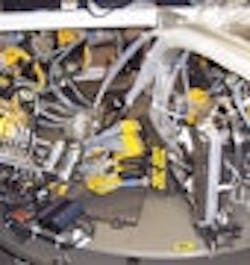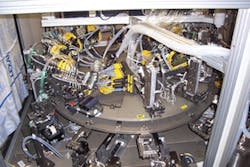Poised for Resurgence
MTA was founded as Missouri Tooling & Automation in 2004, a privately held industrial automation solution provider with more than 80 years of experience in its management team.
We provide complete custom design-and-build, as well as build-to-print, solutions, says Don Buttram, director of project management at MTA, which employs 30 people at its facilities in Lebanon, Mo. Almost a quarter of them are mechanical or electrical engineers or technicians. It has a global partnership in Singapore. The facilities serve Asian, European, North American and South American markets, but 60% of MTAs customer base is in the U.S.
Inkjet Test Dial
Robotically fed counter-rotating servo-driven dials use vision analysis tools to evaluate product performance. This machine produces 25 ppm.
Source: MTA
Labor-intense manufacturing giants tend to gravitate toward southeast Asia and northern Europe in search of more economical human capital, explains Buttram. MTAs flexibility and lean-management practices positions us to take advantage of a potential resurgence of U.S.-based manufacturing due to increased global logistics costs, he says.
The move toward PC-based machine control is growing, says Buttram. We see a definite trend toward digital networking, he says. With higher I/O count machines, traditional hardwiring costs are difficult to sell. Weve completed projects with distributed I/O communicating via Ethernet, and we see this as a growing trend.
All MTA automated solutions have safety relays or safety systems. Our entry-level machines meet Category 3 safety requirements, explains Buttram. Again, we look at Ethernet as the future of automation communication. Cost-effective cabling, global familiarity and networking simplicity are key selling points. If we incorporate a new controls technology that reduces our build effort or improves the customers operating efficiency over the life of the machine, its a no-brainer.
MTA negotiates after-sales support during the quoting phase. This support can vary, depending on the customers needs. Sometimes, it might be none at all. MTA also provides a recommended list of commercial spare parts with the machine documentation package while fabricated spare parts are quoted as requested by the customer. In the event of a failure, our first goal is to get the machine operational again as quickly as possible, says Buttram. The failure then will be evaluated, the negotiated warranty period reviewed, and cost responsibility discussed.
Buttram sees other trends affecting MTAs machine controls over the next few years, including RFID and industrial versions of wireless communications. Our goal is to build control panels with elementary circuits being the only hardwired components, he says. We see plug-and-play, quick-connect, distributed I/O via Ethernet as the trend.


